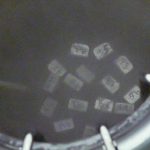Suspended Animation as Living Archive
To freeze sperm, eggs or embryos in liquid nitrogen is a way of stopping time. It is a fleshy database. Cryogenics is cryopreservation. Suspended animation usually implies space travel. It is a way of stopping the clock on a living being (or a sample/portion of a living being). This metabolic slowing is not that different from freezing some steaks or other raw foods for later thawing. But, in the case of embryos and germs cells, they have the capability to be reanimated into the life world. They can be thawed into viable offspring, become part of a new fertilization, be implanted into a future uterus or artificial womb and continue the lineage after a pause. This is a sort of database that is not digital, a preservation of samples that are temporarily still lives. By archiving potential reproductive futures, there is a feeling of uncanny delay. Cryogenic storage tanks, Dewar’s flasks and thermoses of various sizes house and transport libraries that are not allowed to live and not allowed to die. Hoarded hordes are banked in hovers between sky and earth.
FYI: James Dewar’s Vacuum Flask, 1892 Original CryoPreservation Vessel
“glass flasks fitted one inside the other and sealed at the neck with a partial vacuum between them. The central flask is therefore insulated, keeping the contents cold and slowing down evaporation.
James Dewar invented the flask in the course of his cryogenic research; he had been interested in liquid gases for over ten years, first demonstrating the research of others (performing the first public demonstration in Britain of the liquefaction of oxygen) and then beginning his own investigations. Forcing gases to the extremely low temperatures at which they become liquid was a very expensive process so it was important to keep them liquid long enough to investigate their properties.
Dewar had developed a vacuum insulated goblet in 1872 in collaboration with Peter Tait at Edinburgh in order to keep substances warm. Twenty years later he took a similar idea to create a vacuum jacketed flask. The flask, with its narrower neck, was designed especially to keep substances very cool. This initial design was later improved by narrowing the neck even further and putting a silvered coating on the outside to minimize heat loss.”
From: RI Sci Explo








